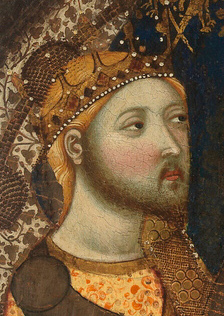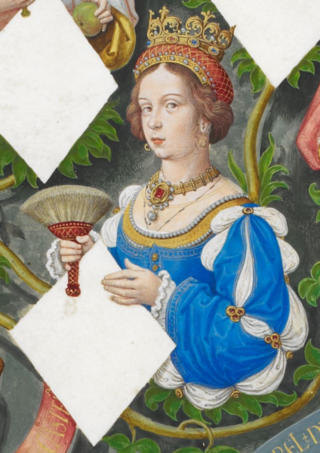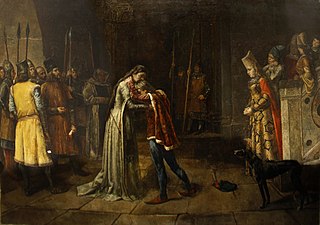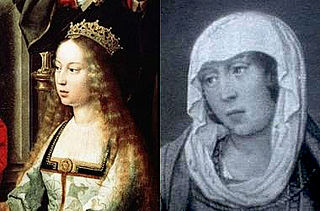Castile or Castille is a territory of imprecise limits located in Spain. The use of the concept of Castile relies on the assimilation of a 19th-century determinist geographical notion, that of Castile as Spain's centro mesetario with a long-gone historical entity of diachronically variable territorial extension.

Ferdinand II, was a member of the Castilian cadet branch of the House of Ivrea and King of León and Galicia from 1157 until his death.

Ferdinand IV of Castile called the Summoned, was King of Castile and León from 1295 until his death.

Henry II, called Henry of Trastámara or the Fratricidal, was the first King of Castile and León from the House of Trastámara. He became king in 1369 by defeating his half-brother Peter the Cruel, after numerous rebellions and battles. As king he was involved in the Fernandine Wars and the Hundred Years' War.

Beatrice was the only surviving legitimate child of King Ferdinand I of Portugal and his wife, Leonor Teles. She became Queen consort of Castile by marriage to King John I of Castile. Following her father's death without a legitimate male heir, she claimed the Portuguese throne, but lost her claim to her uncle, who became King John I of Portugal, founder of the House of Aviz.

Joan of Portugal was the Queen of Castile as the second wife of King Henry IV of Castile. The posthumous daughter of King Edward of Portugal and Eleanor of Aragon, she was born in the Quinta do Monte Olivete Villa, Almada.

Eleanor of Alburquerque was a Castilian noblewoman, Countess of Alburquerque, who became Queen of Aragon by her marriage to Ferdinand I of Aragon. She was the regent of Aragon during the absence of her son the king in 1420.

Leonor (Eleanor) de Guzmán y Ponce de León (1310–1351) was a Castilian noblewoman. After about 1330, she became the long-term mistress and favourite of Alfonso XI, with whom she had the illegitimate son Henry "the Fratricidal", future first monarch of the House of Trastámara. She held the lordship of Medina-Sidonia until she fell from grace in the wake of Alfonso's death in 1350. She was then executed by her enemies.

Medina del Campo is a town and municipality of Spain located in the autonomous community of Castile and León. Part of the Province of Valladolid, it is the centre of a farming area.

The Crown of Castile was a medieval polity in the Iberian Peninsula that formed in 1230 as a result of the third and definitive union of the crowns and, some decades later, the parliaments of the kingdoms of Castile and León upon the accession of the then Castilian king, Ferdinand III, to the vacant Leonese throne. It continued to exist as a separate entity after the personal union in 1469 of the crowns of Castile and Aragon with the marriage of the Catholic Monarchs up to the promulgation of the Nueva Planta decrees by Philip V in 1716.

The War of the Castilian Succession was the military conflict contested from 1475 to 1479 for the succession of the Crown of Castile fought between the supporters of Joanna 'la Beltraneja', reputed daughter of the late monarch Henry IV of Castile, and those of Henry's half-sister, Isabella, who was ultimately successful.

María Alfonso Téllez de Meneses, known as María de Molina, was queen consort of Castile and León from 1284 to 1295 by marriage to Sancho IV of Castile, and served as regent for her minor son Ferdinand IV and later her grandson Alfonso XI of Castile (1312-1321).

Ferdinand II, called Ferdinand the Catholic, was King of Aragon from 1479 until his death in 1516. As the husband and co-ruler of Queen Isabella I of Castile, he was also King of Castile from 1475 to 1504. He reigned jointly with Isabella over a dynastically unified Spain; together they are known as the Catholic Monarchs. Ferdinand is considered the de facto first king of Spain, and was described as such during his reign, even though, legally, Castile and Aragon remained two separate kingdoms until they were formally united by the Nueva Planta decrees issued between 1707 and 1716.

Isabella I, also called Isabella the Catholic, was Queen of Castile and León from 1474 until her death in 1504. She was also Queen of Aragon from 1479 until her death as the wife of King Ferdinand II. Reigning together over a dynastically unified Spain, Isabella and Ferdinand are known as the Catholic Monarchs.

Pedro Fernández de Castro "the Castilian" was a Castilian nobleman, son of Fernando Rodríguez de Castro and Estefanía Alfonso la Desdichada. He inherited the Infantazgo of León from his parents and was mayordomo mayor of Fernando II and his son Alfonso IX of León.

Juan Pacheco, 1st Duke of Escalona, better known as Juan Pacheco, Marquess of Villena, was a Castilian noble of Portuguese descent who rose to power in the last years of the reign of Juan II of Castile and came to dominate the government of Castile during the reign of Juan II’s son and successor Henry IV of Castile. Created The 1st Duke of Escalona in 1472, his other titles included, among others, Marquess of Villena and Master of the Order of Santiago.

Diego López V de Haro, nicknamed el Intruso, was a Castilian noble of the House of Haro and held the title of the Lord of Biscay which he took from the pretender to the title, John of Castile.

The coat of arms of Castile was the heraldic emblem of its monarchs. Historian Michel Pastoureau says that the original purpose of heraldic emblems and seals was to facilitate the exercise of power and the identification of the ruler, due to what they offered for achieving these aims. These symbols were associated with the kingdom, and eventually also represented the intangible nature of the national sentiment or sense of belonging to a territory.

The Castilian House of Ivrea, also known as the House of Burgundy, is a cadet branch of the House of Ivrea descended from Raymond of Burgundy. Raymond married Urraca, the eldest legitimate daughter of Alfonso VI of León and Castile of the House of Jiménez. Two years after Raymond's death, Urraca succeeded her father and became queen of Castile and León; Urraca's and Raymond's offspring in the legitimate line ruled the kingdom from 1126 until the death of Peter of Castile in 1369, while their descendants in an illegitimate line, the House of Trastámara, would rule Castile and Aragón into the 16th century.

The term Liga Nobiliaria is generally used to designate political movements of nobles of the Kingdom of Castile that arose in the 14th and 15th centuries. They are equivalent to today's parties, and were motivated mainly by attempts of monarchs to diminish the opposition's powers and privileges.
























